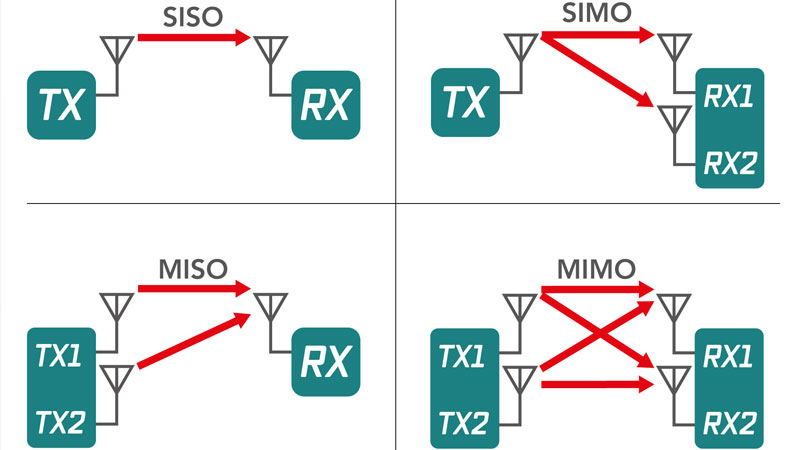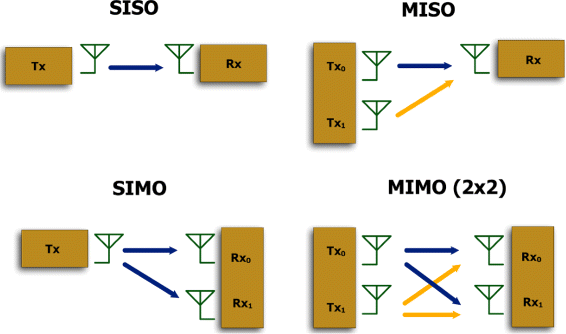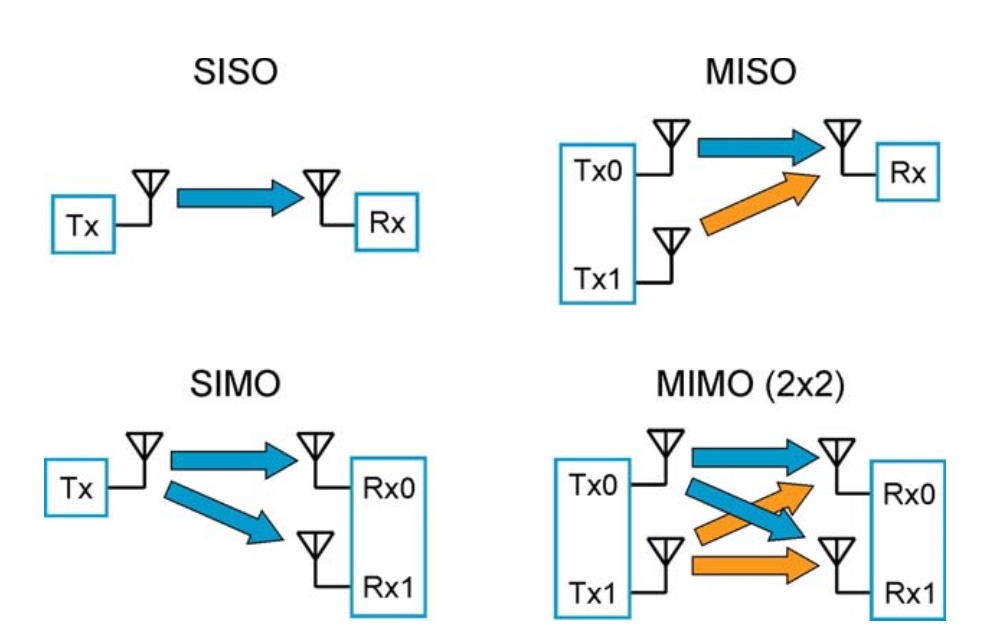Perplexing and bursting with technical details, the wireless communication world is home to two different radio systems – SISO and MIMO. Single Input Single Output (SISO) employs only one antenna at the transmitter and receiver ends, while Multiple Input Multiple Output (MIMO) uses multiple antennas on both sides of the communication channel.
Antennas hold an integral role in both these systems. SISO relies on a single antenna for signal transmission, whereas MIMO utilizes several antennas to transmit signals simultaneously via various spatial streams. The result? Unparalleled data rates and superior quality of service that surpasses what SISO can offer.
If you’re looking for more efficiency in your wireless communication system, then it’s worth considering MIMO over SISO as it offers greater spectral efficiency. Spectral efficiency pertains to how effectively a given frequency spectrum can be harnessed to transmit information across channels without interference. Since MIMO deploys multiple antennas concurrently with minimal disruption between them, it delivers higher spectral efficiency than its counterpart – which relies solely on one antenna for all transmission purposes!

Exploring the Role of Antenna Systems in SISO and MIMO Communication
Contents
- 1 Exploring the Role of Antenna Systems in SISO and MIMO Communication
- 2 The Advantages of MIMO over SISO in Terms of Spectral Efficiency
- 3 The Impact of Multipath Fading on SISO and MIMO Systems
- 4 How MIMO Technology Improves Communication Throughput and Reliability
- 5 Beamforming and Spatial Multiplexing: Key Techniques Used in MIMO Systems
- 6 MIMO
- 7 Real-World Implementation of SISO and MIMO Technology in Wireless Communication Systems.
Antenna systems, oh how they mystify! These enigmatic devices are the backbone of both SISO and MIMO communication, but what sets them apart? In a SISO system, only one antenna is used to send and receive signals. But hang on – don’t get too comfortable with that idea just yet! The signal quality received can be affected by all sorts of factors such as distance, obstacles and interference from other devices. And let’s not forget about those pesky atmospheric conditions causing fading.
But wait, there’s more! With multiple antennas at your disposal in an MIMO system, these limitations can be overcome. Multiple antennas mean better utilization of available bandwidth which leads to higher spectral efficiency compared to their single-antenna counterpart. Different configurations depending on application requirements – SIMO or MIS0 or even MIMO with diversity!
And that’s not all…multiple antennas can also help reduce multipath fading (yes folks, it gets worse). This occurs when signals reflect off different surfaces interfering with each other leading to degradation of our precious information transmission. But have no fear! By exploiting spatial diversity through beamforming techniques in an MIMO system we can distinguish between direct path signals and reflections improving performance overall.
So you see now why antenna systems play such a crucial role in wireless communication? Whether it’s relying on SISO or MIMO technology for transmitting information over long distances reliably and efficiently – these perplexing systems hold the key.

The Advantages of MIMO over SISO in Terms of Spectral Efficiency
MIMO technology, with its superior spectral efficiency compared to SISO, has taken the wireless communication world by storm. But what makes MIMO stand out from the rest? Well, for starters it uses multiple antennas at both ends of the transmission line which allows for simultaneous data transfer over a given bandwidth. This means that more information can be transmitted than ever before!
But that’s not all – MIMO also has an amazing ability to mitigate multipath fading (when signals bounce off obstacles and arrive out of phase) by using reflections to create extra paths for transmitting data streams. The result is an overall increase in throughput and reduction in interference.
Spatial multiplexing is another technique used in MIMO systems which contributes further to their high spectral efficiency. By transmitting different data streams through separate spatial channels, more data can be transferred within a given frequency band! And when combined with beamforming – which focuses radio waves towards specific receivers or areas – signal quality improves even further.
IEEE standards have recognized these benefits since 2003 and have included MIMO as part of their wireless communication standards. As technology continues to advance and channel capacity increases, we can only expect MIMO’s advantages in terms of spectral efficiency and reliable communication to grow stronger still!
The Impact of Multipath Fading on SISO and MIMO Systems
The transmission of radio signals in both SISO and MIMO systems is under threat from an enigmatic phenomenon known as multipath fading. This perplexing occurrence arises when numerous versions of the same signal reach the receiver with varying phases, courtesy of reflections, diffraction, and scattering from physical objects like buildings, trees, and terrain. The outcome? A distorted received signal that can cause data transmission errors.
SISO systems are particularly susceptible to this issue as it significantly reduces received signal quality by weakening its strength while increasing noise levels. This effect is more pronounced in cellular networks where users usually find themselves indoors or surrounded by obstacles that either reflect or absorb radio waves. Consequently, several techniques have been developed to mitigate this problem such as diversity combining schemes utilizing multiple antennas or frequency hopping methods.
MIMO technology offers a bursty solution for combating multipath fading since it deploys multiple antennas on both ends of the communication link to transmit and receive data simultaneously along different paths. By exploiting spatial diversity through beamforming or spatial multiplexing techniques, MIMO boosts the signal-to-noise ratio (SNR), enhances reliability and throughput rates even under harsh channel conditions characterized by high scattering environments. However, achieving these benefits requires careful design considerations such as antenna placement optimization and channel estimation algorithms to accurately decode multi-antenna transmissions at the receiver end without introducing additional interference or delays into the system.\n
How MIMO Technology Improves Communication Throughput and Reliability
The world of wireless communication has been utterly transformed by the advent of MIMO technology, which utilizes a multitude of antennas at both transmitter and receiver ends. This novel approach permits simultaneous data transmission and reception, leading to vastly improved throughput and reliability. By contrast, SISO systems can only handle limited data rates due to their incapacity to combat interference via spatial multiplexing.
Antenna systems are instrumental in facilitating MIMO communication as they enable beamforming that focuses radio signals towards specific users or areas. Advanced antenna technology such as smart antennas with adaptive parameter control allows MIMO systems to optimize signal strength while minimizing interference from other sources. Moreover, coding schemes can be implemented for added performance enhancement through error correction capabilities.
Academic research reveals that MIMO technology provides substantial advantages over SISO in terms of channel capacity and data rates. Unlike SISO’s limitations imposed by bandwidth availability within a single frequency band, multiple bands may be utilized simultaneously under MIMO achieving augmented spectral efficiency. Beamforming techniques further enhance this by directing transmission power towards specific users or locations resulting in better utilization of available frequencies overall; thus contributing significantly toward real-world implementations of wireless networks employing MIMO technology’s enhanced communication throughput and reliability factors!
Beamforming and Spatial Multiplexing: Key Techniques Used in MIMO Systems
The utilization of beamforming and spatial multiplexing in multiple-input, multiple-output (MIMO) systems has completely transformed the wireless communication landscape. These cutting-edge antenna technologies have been instrumental in enhancing data transmission’s reliability and throughput.
Beamforming, a technique used in MIMO systems, is an enigma that employs numerous antennas to direct radio signals towards specific locations or directions. This method bolsters signal quality and strength while reducing interference from other sources. Moreover, it also leads to better coverage range for wireless networks like 4G/LTE and IEEE 802.11n.
Another perplexing yet crucial technique employed in MIMO antenna diversity is spatial multiplexing. It utilizes several antennas at both transmitter and receiver ends to transmit many streams of data concurrently over one frequency band. The outcome is higher spectral efficiency, allowing more information to be transmitted within a given time frame.
Thanks to these techniques’ implementation, there have been tremendous enhancements in wireless communication system performance by increasing capacity while minimizing errors caused by fading channels; thus boosting overall network reliability significantly! With continued technological advancements on the horizon, we can expect even grander improvements across various industries utilizing future MIMO-based systems’ capabilities and applications!
MIMO
MIMO technology boasts a key advantage – its ability to provide diversity gain, enhancing signal reliability. This feat is accomplished through the use of multiple antennas at both transmitting and receiving ends. By sending various signals over diverging paths, MIMO compensates for fading caused by multipath interference, allowing dependable signals to reach their destination.
But that’s not all; MIMO also utilizes space-time coding techniques to bolster spectral efficiency and data rates. With an optimal antenna configuration, MIMO systems can achieve higher bandwidth utilization in comparison with SISO systems. And let’s not forget about the number of antennas used in a MIMO system – more antennas equate to better throughput and greater redundancy.
The benefits offered by MIMO have made it an integral part of wireless communication standards like 3G and LTE. Modern-day implementations employ beamforming and spatial multiplexing as two key techniques that further amplify system performance. As wireless communication continues on its evolutionary path, we can expect novel advancements in RF technologies that will continue pushing the boundaries of what’s possible with this thrilling area of engineering research!
Real-World Implementation of SISO and MIMO Technology in Wireless Communication Systems.
The ins and outs of MIMO technology versus SISO are a maze of advantages, disadvantages, and nuances that can leave even the savviest wireless communication aficionado feeling perplexed. However, one key advantage of MIMO is its ability to handle multiple streams and access techniques simultaneously, leading to faster data transfer rates – an essential feature in modern WiMAX systems where link reliability is critical.
Of course, this doesn’t mean that implementing MIMO comes without complications. On the contrary, real-world situations often involve issues like multipath fading or unreliable links that require spatial diversity techniques such as beamforming or transmitting multiple copies for mitigation. Even so, with proper channel state information (CSI) feedback and array gain from extra antennas compensating for attenuation due to distance or obstacles, these challenges can be managed.
To make matters more complex still, both SISO and MIMO technologies have 3GPP standards set by regulatory authorities in place- but while simpler applications may benefit from straightforward SISO implementation; advanced scenarios demand the flexibility and benefits provided by sophisticated antenna arrays in MIMO systems. A fitting comparison might be walking vs driving: while both will get you where you need to go eventually -driving offers greater speed & adaptability when dealing with longer distances or trickier routes involving alternate paths -just like how using MIMO technology helps overcome various communication hurdles expertly!


